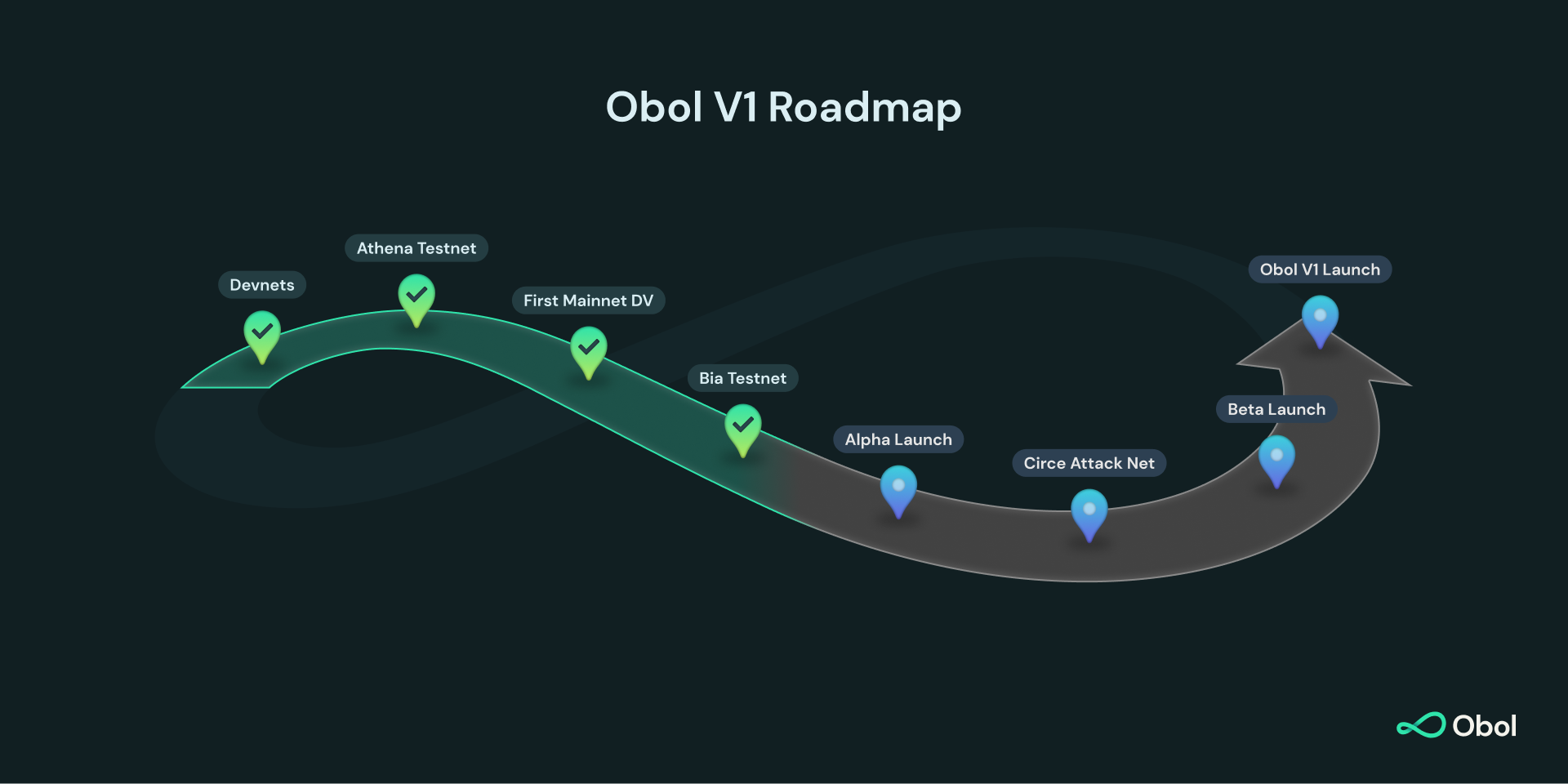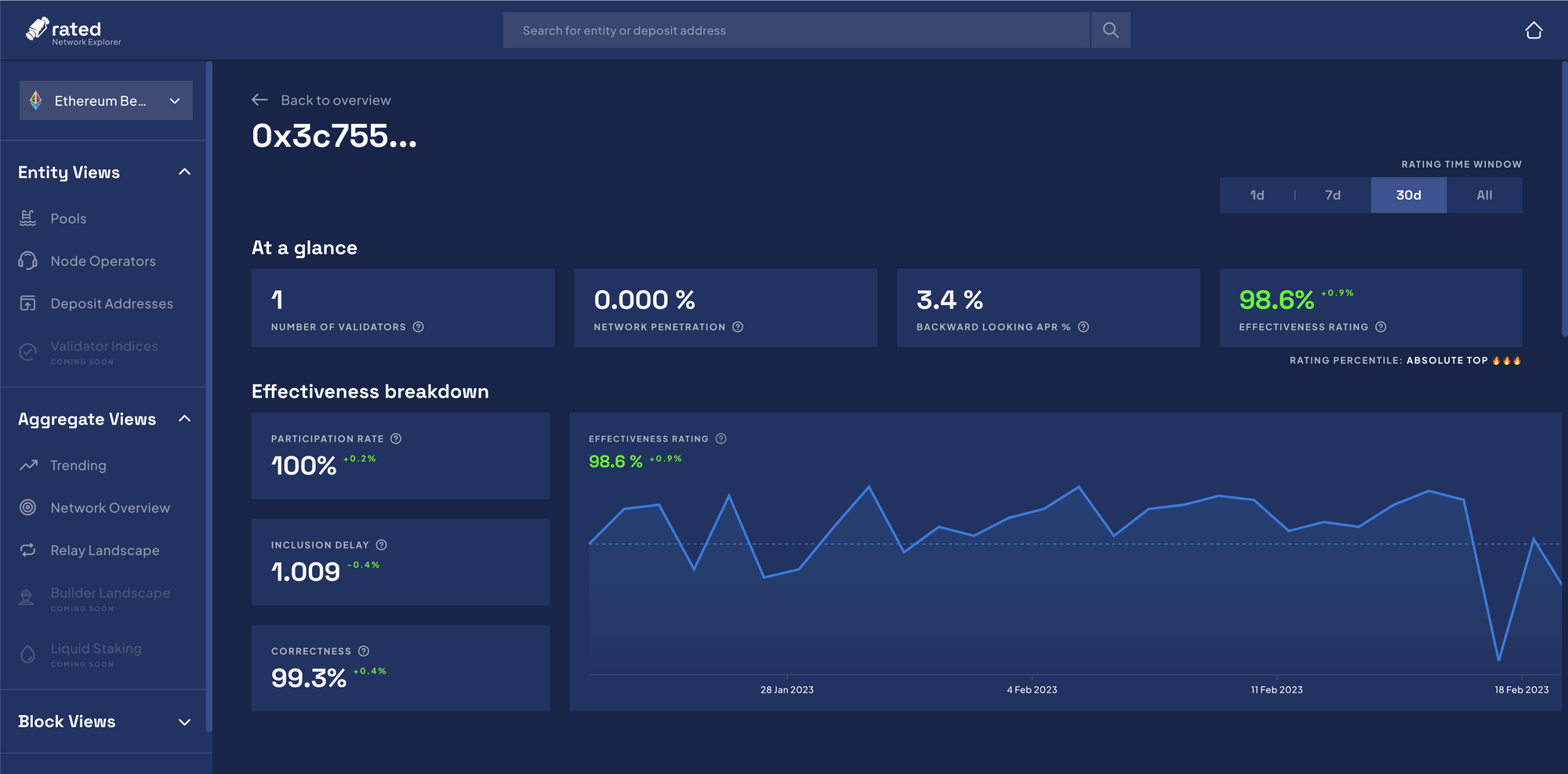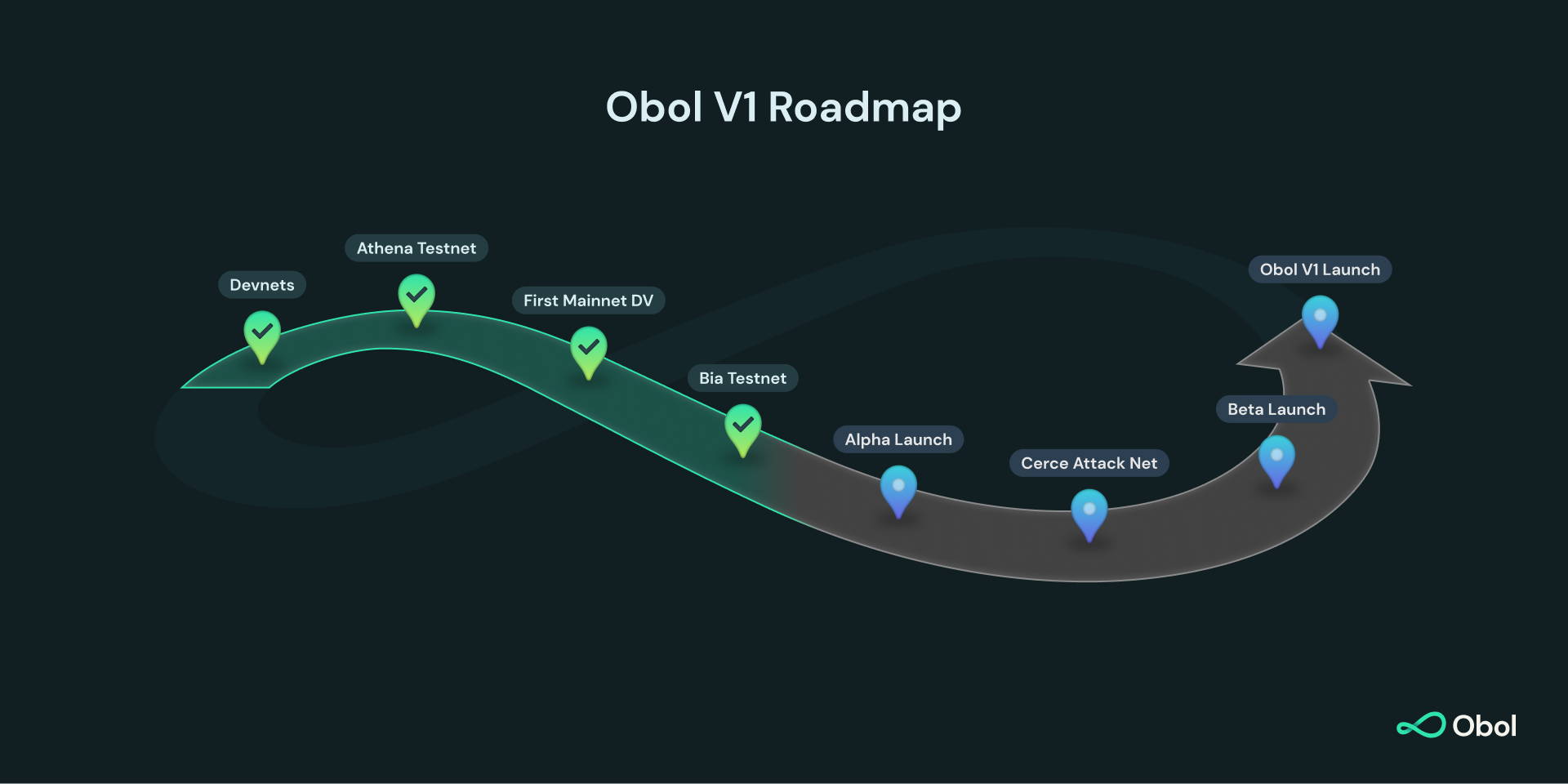Road to Mainnet for Distributed Validators
Today, we announced Ethereum Mainnet’s first distributed validator! This marks the first phase of Obol’s journey to bringing DVs to Mainnet Ethereum. Here, we will walk through our current design philosophy, protocol roadmap, and adoption strategy.

Today, we announced Mainnet Ethereum's first distributed validator! This huge milestone signals the dawn of a new chapter in Ethereum staking, one that is more secure, resilient, and decentralized for all validators and stakers alike.
The successful launching of the world's first DV comes on the back of 3 years of research, 2 years of development, and 9 months of testing (with two testing programs, Athena and Bia). The strong performance of the validator demonstrates the promise of DVT to improve the performance, resiliency, and security of Ethereum validators, especially for those who choose to run validators from home.
The validator, named dv494484.eth, consists of nodes run from Ireland, Estonia, and Canada. Each node is run entirely at home, the purest form of validation. Since the first DV’s activation, it has performed impressively well racking up a total of 10,860 successful attestations with an average effectiveness of 98.6% as of Feb. 22, 2023. More importantly though, despite its geographical diversity, the validator displays a competitive average inclusion distance of 1.009 (shorter than the network’s average of 1.021).

This marks the first phase of Obol’s journey to bringing DVs to Mainnet Ethereum. Today we are happy to report that adoption and coordination is ahead of schedule for Obol. In the coming weeks, we will share a series of critical updates and community calls as we march towards the Obol V1 milestone.
Below, we will walk through our current design philosophy, protocol roadmap, and adoption strategy.
Obol DV Design Pillars
When designing and implementing our V1, we used a set of design pillars that were inspired by Ben Edgington’s OG post on the design philosophy of Serenity (then Eth2). Below is how we approached our V1 north stars.
- Resiliency: Remove validators as single-points-of-failure in the network
- Decentralization: Enable protocol to be easily accessible by all validator types and sizes
- Security: Improve the security of a validator by including distributed key cryptography
- Anti-Correlation: Design DVT in a way that itself doesn’t become a vulnerability
- Performance: A Distributed Validator must perform equal to or better than a normal validator
In a future blog we will describe these design pillars in more detail.
Obol DVT Adoption Strategy
Rolling out DVT will be similar to how it was built: in the open, constructive, and highly collaborative. For DVT, adoption will take place in waves similar to the roll out of Eth2 (for all of our Phase 0, 1, 1.5, and 2 people!). The successful launch of dv494484.eth is our version of Phase 0, a first step in our journey to Obol V1.
As DVT popularity increases, it is important that early implementations of DVT maintain performance with current validators. This is critical for early adoption and continued support from the growth for the validator ecosystem, and something we have placed a strong emphasis on when designing, implementing, and testing Obol. As we build for the future, we are also focused on stressing the performance of Charon with all validators types; the Mainnet DV is running in the homes of core team members spread across 3 continents. Our vision of the future includes validators being shared by participants across the world, this dramatically influences the way we design, introduce, and test Obol DVT.
Due to the diversity in Ethereum validator types, we will take a phased approach to rolling out Obol. At each phase we will target certain user groups to focus our attention. This will improve the long term DVT plumbing of critical Ethereum infrastructure verticals (i.e. LSP’s, at-home validators, DeFi, etc.). This allows the project to maintain performance, security, and usability while delivering value to the Ethereum ecosystem. Each phase in the roadmap will also lay the groundwork for the next phase.
Here is what this looks like.
Obol V1 Roadmap

The research, design, and implementation of Obol V1 has been 24 months in the making and is now reaching an impressive point of stability on its roadmap. We once thought we were going to build DKG into the browser (LOL)!
At the beginning of our journey we struggled with the communication of V1, which pushed us to focus on our language and scope early on. After an incredible series of sessions spread across 5 weeks we worked with Deep Work Studio to stand up the initial branding, information hierarchy, mission alignment, feedback, and design of the DV Launchpad.
Through that exercise we were able to break down the Obol Network into 4 functional areas, which are Create, Test, Run, and Coordinate. Once we organized the effort through these pillars we were able to start building them out with working groups, scope, and resources.
Together these 4 functional areas have influenced the Obol roadmap and features of Obol V1, which is the first push that stands up the foundation for a global infrastructure network of distributed validators.
Across the pillars of V1, the Obol Network develops and maintains four core pieces of infrastructure.
- The DV Launchpad - A web app for the migration to or creation of an Obol Distributed Validator
- Charon - A middleware client enabling fault tolerant Ethereum validators
- Obol Managers - A suite of smart contracts that enable validators to be economically shared amongst groups
- Obol Testing Programs - A series of on-going coordination events and tooling for testing permissionless distributed validators
Within Obol V1, we will also be taking a phased rollout approach.
Pre-Alpha: Deploy the first mainnet DV
In order to see how a DV performs on mainnet, you need to put it there. We decided to deploy the first one with stretched geo diversity before we submitted for our first audit to accelerate latency understanding and performance testing. The pre-Alpha phase also includes submitting for our first audit with Sigma Prime (next week!) and the successful completion of a DVT performance report created by the Miga Labs team. The good news is, the first mainnet DV is running splendidly!
Alpha: Push the total number of DV validators to 1% of active validators
The next step will be to launch Obol with a group of trusted partners to progressively integrate Obol into existing and to be launched staking applications. This phase will begin once we complete audits and address any changes required. Launching in this way allows us to provide the necessary attention to ensure that early large scale deployments are built with collaboration and care. This enables us to capture more complex learnings in preparation for the V1 Launch. We are currently working closely with partners, and will ensure representation for all validator types.
Beta: Push the total number of DV validators to 5% of active validators
Upon successful completion of the Alpha launch, we will begin to open up Obol to a wider audience of user types and project integrations using a business license. This allows us to take early learnings to scale adoption by multiples seen in the Alpha phase. Our primary focus is ensuring the protocol maintains the quality necessary as more operators adopt the technology.
V1 Launch: Allow all operators to deploy Obol DVs on mainnet
The public launch phase of our mainnet journey marks the completion of the Obol V1 journey. By this time we hope to have ~10% of the network stake protected by DVT. Upon completion of our Alpha and Beta phases, we will have gone through all of our V1 testing and audits, ensuring the performance, security, and usability of the product. At this point we intend to recommend Obol for broad use for all validator types.
During the Obol V1 phase, we will run a total of three testing programs.
Athena (and OOC) (Concluded)
The Athena testing program was our first public testnet that took place from July to September 2022, and launched at the same time, the Obol Operator Community (OOC) brought professional validators to test DVT for the first time within their environments. Together, this was the first comprehensive set of testing programs we ran to put DVT into the hands of validators.
Through the efforts of our community, we were able to activate 100+ DV Clusters across 40+ countries, predominantly with at-home validators. On average, these clusters showed high performance, with avg. inclusion delay in the 1.57 range and proposer effectiveness near 100%, performance numbers that are all comparable to current top validators. Through these testing efforts, we verified the ability for distributed validators to run with high performance while reducing downtime.
Bia (Active)
The Bia testing program, which is currently underway, aims to test how Obol scales, both in terms of performance and usability. The goal is to activate >500 clusters globally and see if at-home validators can create DV clusters in a self-service manner without a lot of support. At the same time, we are also testing Bia with professional operators and scaling clusters to run 1000 validators to test the vertical scaling capabilities of the protocol.
Bia has been active for a little over 3 weeks, and the initial results are overwhelmingly positive. We’ve already crushed our cluster goal with >650(!!) clusters registered with at-home validators finding each other only through a Discord channel in our community and using the DV launchpad to configure their cluster. We will monitor the performance of these clusters as they come online and start running.
Circe (Upcoming)
The Circe testing program is a planned attack net that will occur after the Beta launch. Circe will test the protocol to find potential vulnerabilities and limitations in the protocol, such as the slashable risk of Obol DVT. This is a critical final step for the protocol to go through in order to ensure it is fully secure for the public launch phase.
Obol V2
While the roadmap to V1 is an exciting one, we have been actively working on our vision for Obol V2. Obol V2 is primarily focused on the trust minimization of distributed validators through enhanced applied cryptography and cryptoeconomics. We have recently selected a partner and core development team to partner with on the research and build of Obol V2. We expect to announce more exciting news on this front in the 2Q !!
The end state of Obol is a multi-client DVT protocol that allows any validator to join clusters without trusting (or even knowing) who the other operators are in the same cluster. The phases of V1 will establish the foundation for the high-performance, security, and usability that is necessary for Obol V2 to be built on top of.
How to get involved
If you’re excited about DVT and want to get involved in progressing the technology, there are many ways you can do so.
Join The Core Team
Obol is hiring across the stack and across the world. Today the core team consists of 24 participants and 17 advisors that work closely together on R&D and furthering the adoption of DVT. We’re looking for talented people who’re passionate about building the future of staking to join us! You can find all our openings on our jobs page.
Participate in the Bia testing program
We are still actively welcoming at-home and professional validators to take part in Bia. If you’re an at-home validator, you can find out how to register for the testing program in our Bia Handbook. If you’re a professional validator, please connect with us at [email protected].
Contribute to our Ambassador Program
In addition to participating in the testing program, there also needs to be more content and information shared about DVT in different languages around the world. To promote, and reward, further education on DVT, we have established the Obol Ambassador Program. If you are interested in writing or translating materials, please check it out!
Educate yourself on DVT
Even if your schedule does not allow for deep involvement, we encourage anyone who’s a validator or stakes ETH to educate yourself about DVT. DVT will become a standard security middleware for the entire staking ecosystem, and it’s important for you to understand its benefits and ensure that your staked ETH is protected. Here’s a short list of resources created by the community to get you started:
- What is DVT? (by Corver Roos and Brett Li @ Obol Labs)
- Sorting out Distributed Validator Technology (by Isaac Villalobos @ Nethermind)
- A tour of Verifiable Secret Sharing schemes and DKG protocols (by Ignacio Manzur Tomasini
@ Nethermind) - Enhancing Ethereum’s Resilience With DVT (by Stephanie Dunbar @ Messari)
- How DVT Helps Liquid Staking Protocols (by Brett Li @ Obol Labs)
- Understanding Ethereum Staking Deposits (by Jim McDonald @ Attestant)

